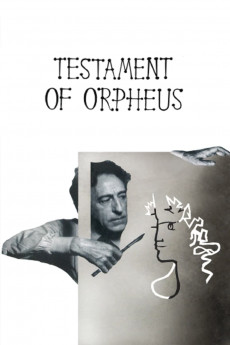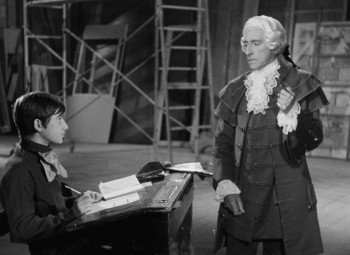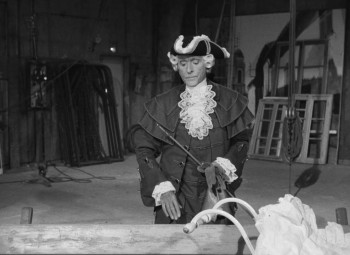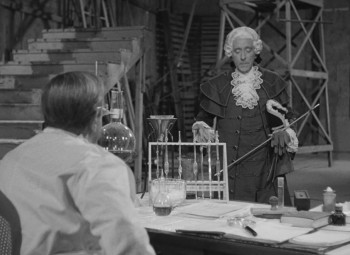Testament of Orpheus (1960)
1960
Action / Biography / Fantasy
Testament of Orpheus (1960)
1960
Action / Biography / Fantasy
Testament of Orpheus (1960) Synopsis
From the Criterion Collection DVD Cover: "In his last film, legendary writer/artist/filmmaker Jean Cocteau portrays an 18th century poet who travels through time on a quest for divine wisdom. In a mysterious wasteland, he meets several symbolic phantoms that bring about his death and resurrection. With an exlectic cast that indludes Pablo Picasso, Jean-Pierre Léaud, Jean Marrais, and Yul Brenner, 'Testament of Orpheus' (Le Testament d'Orphée) brings full circle the journey Cocteau began in 'The Blood of a Poet,' an exploration of the tortuous relationship between the artist and his creations."The film opens with the final scene of Orphee (1950) - the previous film in this trilogy.The narrator (Cocteau) describes his film and cinema's relation to the audience in general.The scene cuts to a boy working at his desk as a man dressed in colonial attire materializes before him. He is searching for a professor and asks the boy if he is the professors son. The boy is not the son of a professor, but hopes to one day become a famous professor. The man vanishes in response leaving the boy stunned. He reappears only to retrieve his forgotten gloves. The same man then sneaks up and startles a woman causing her to drop her infant son. He worries he has muddled her destiny. This is his second encounter. His third encounter is with a frail old man being strolled in his wheelchair by a nurse. It's revealed this is the professor who as an infant was dropped on his head by his mother. The man vanishes just before the professor passes away. The professor drops a box of bullets that the man claims will set him free. (~6:50)The film cuts to the professor as a middle aged man resting between research. The same strange man appears before him who the professor recognizes from his youth as a boy. The man reveals he has been searching for the professor while lost in space-time, and it should be 2209, not 1959. He reveals the bullets he previously recovered from the older professor which the man reveals can travel faster the light and can save him because of that property. He wants to be shot. The professor shoots him causing him to fall downwards, then upwards now dressed as a modern man. He has become his modern self, Cocteau - the poet and film director of this trilogy. He leaves the professor's lab and walks down a dirt road. (~14:00)He has passes a man dressed in skin tight black wearing a horse head. They glance at one another after there is some distance between them. Cocteau follows the horse man into what appear to be stone ruins. In the ruins he finds a pow-wow of colony with a flamenco guitar player and various people mingling and sitting around a fire. From the flames a picture of Cegeste (a character in the film Orphee [1950]) is created which the professor recognizes, and is presented to a woman surrounded by followers who glare at Cocteau. The woman tears the photo into four and hands it to Cocteau. He leaves followed by the horse-man. Cocteau regrets following the horse-man. (~19:45)He approaches a cliff by the sea and tosses the photo into the ocean from which Cegeste springs to life. Cegeste has been removed from cinematic confines and is now real. He hands Cocteau a dead flower and asks that he follow him. They venture toward a lighthouse. (~21:20)A story of Nebuchadnezzar is recounted in a tapestry hanging on a wall. A young woman approaches a podium in front of the tapestry and is questioned by a man before her on Greek myth. He asks her about Cocteau as Cocteau and Cegeste approach. The two men pass through the area to arrive at a green house. Cocteau removes a painting from a canvass and begins to try to paint the dead flower to no avail. Cegeste (now wearing a skull mask) reveals, "An artist always paints his own portrait. You'll never paint that flower". Cocteau destroys the flower in rage, but Cegeste collects the pieces in a pot. Later, Cocteau reassembles the flower by hand. Cegeste demands Cocteau accompany him to the goddess Minerva (or Athena). Cocteau refuses initially causing Cegeste to lash out at him for events in Orpheus (1950). He places the skull mask on Cocteau forcing him to obey. They meet The Princess (Death) and Heurtebise from Orpheus (1950). (~31:50)The are on a council investigating Cocteau for attempting to travel to another world. He pleads guilty to all charges. Cocteau gives the panel the flower, but it disappears as they demand to know where it came form. Cocteau explains his philosophy of cinema and poetry to the panel as they question him. It is also revealed that Cegeste is actually a painter, and Cegeste is only a pseudonym. Cegeste reveals he was ordered to have Cocteau revive the flower, and it is asked of Cegeste to prove his other-worldly powers. He tells the panel they will have to take his word for it. The panel regresses to questioning Cocteau and summon the professor as witness against him. The professor credits Cocteau for enlightening him to other powers that finished his research, as he had earlier used his research to restore Cocteau to his own time period, though he now ended up in this undead timeless world. The professor asks to question the panel, but expresses a difficulty existing and vanishes. The Princess again questions Cegeste on his intentions, and wonders if he wished to split in two which would remove his unwanted traits. Cegeste claims no malcontent, and the professor adds he can think of no worse punishment than to remain in this middle realm. The panel leaves, but not before Heurtebise explains to Cocteau the outcome of Orpheus, Eurydice, and Hades while giving him back the flower. He also explains that for their interworldly crimes in the previous film, Heurtebise and The Princess are forced to be eternal judges of this world. Cegest and Cocteau come to an accord on their place with each other, and Cegeste reveals the flower holds the same destiny as Cocteau. (~51:35)The film cuts to a mansion with a countess outdoors speaking to her servant. The countess is able to see Cocteau and Cegeste approach, but the servant is not. She blows a whistle which commands a pair of men dressed in underwear and a skimpy Anubis costume to prance about for her. It is revealed by Cegeste that she is a woman in the wrong time era. They leave the mansion and venture to the sea where they board a sail boat. On the boat is Isolde who seeks Tristan. Cegeste and Cocteau dock and venture to a church that houses Cocteau's planned tomb. Cocteau encounters his living self briefly in passing. (~1:00:00)Cocteau and Cegeste continue where they find two intellectuals embracing one another in the ruins from the beginning of this movie.. They give two children their autographs who place the signatures in the mouth of a statue. Cegeste reveals the statue grants celebrity status to anyone for a brief moment. From its six mouths spew all forms of art such as poetry and songs. Cegeste leaves Cocteau but tells him that he is right where he left him. Cocteau explores and finds a man on the phone at a desk who asks Cocteau to wait a moment for the minister. After a very long wait, the man instructs Cocteau to proceed, but to first sign away all his hope. Cocteau approaches a pair of men dressed in black horse outfits, and a women dressed in hoplite attire as he finds the flower reappear in his hand. The hoplite has false eyes glazed by what appears as plactic in gloss.The hoplite and Cocteau stare at one another until the hoplite looks away. Cocteau asks to be excused, turns, and walks away. (~1:09:56)The Hoplite raises its javelin and throws it at Cocteau. It impales him through the upper back.He falls to his knees and falls onto a pile of rubble. The horse-men approach and pull the spear out from him. Onlookers view Cocteau being carried away by the horse-men. The flower now laying on the ground turns red - the first color seen in the film; the color matches the blood next to it. Cocteau's body is taken amongst the people who were watching and resurrected. He leaves the ruins. He walks away now having the same false eyes the hoplite had. He is followed by a spirit for some distance until passing by a man and a woman. (~1:16:49)Cocteau awakens on a road in a remote location from what he imagines is somnambulism. He recognizes the sounds of the motorcycles from his earlier film Orpheus (1950) and is certain that they have come to kill him as they killed Cegeste. As they question him Cegeste materializes and removes him from the scene claiming Earth is not his home any longer. The officers are left confused and stunned by this disappearance. An officer drops his notepad which turns into the flower before hitting the ground. (~1:19:10)Cocteau thanks the audience and says this is his farewell film. He hopes you enjoyed it. (FIN)
Published Time: 2019-08-13 20:32:27








